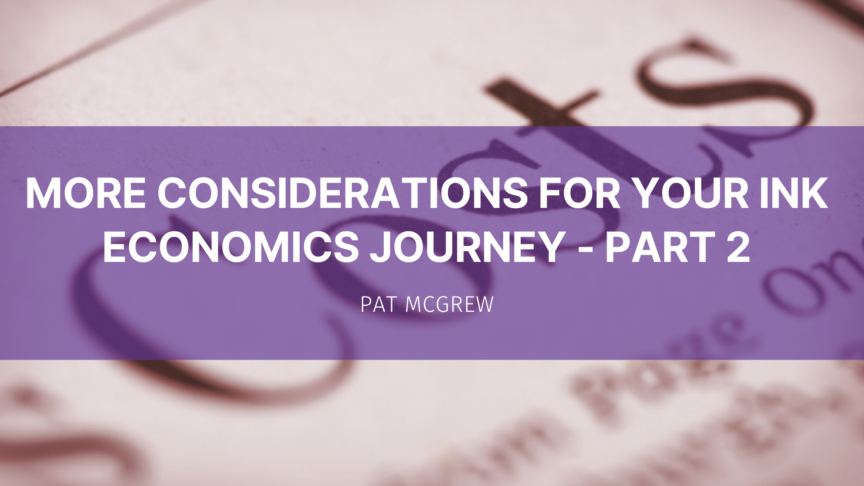In the second installment of your Ink Economics Journey, we explore the value proposition of magic inks that support a wider variety of substrate options, generally without primers and optimizers. Once you have evaluated your ink consumption and what options your vendors provide, it’s time to dive into how your options might change your costs, creating interesting opportunities for pricing differentiation.
The first segment of the inkjet economics journey focused on the understanding that inks come in many flavors. Dye in water or pigments in solutions, including water and oil, changes the way the ink behaves on the target substrate. The question that emerges is whether you should search for magic ink that will print on any substrate or look for the most economical ink options and then fill in with additional fluids if needed.
The suggestion at the end of the article was to assess your current ink set, the fluids you use in addition to the ink, what you print, and how much you use. You may have been surprised with what you learned. You may have discovered that some jobs you thought were low coverage are consuming more ink than you anticipated or priced for. Sometimes, the opposite is true, and jobs that look heavy in coverage don’t take as much ink as assumed.

Why is the Cost of Ink an Issue?
How hard can it be to add some dye or pigment to water, pigment to oil, or colorant to solvents to create a fluid that can be jetted onto a substrate? It turns out that it is more complex than most people realize. It is expensive to formulate inkjet inks because the resulting fluid needs to carry the appropriate amount of colorant, work with the inkjet print heads, land on the substrate with precision and crispness, and dry quickly.
With inkjet presses capable of printing at higher speeds every year, enabled by printheads that jet at higher speeds and using smaller droplets to support great print resolution, the ink must be formulated to match the requirements of the heads. The research, development, and testing are expensive, which is reflected in how inks are priced. The baseline is that inks must be able to produce colors accurately, jet without clogging print head nozzles, and dry quickly.
Using the data you have on the substrates you use, ink use, and the average ink coverage gives you a baseline for consideration. If your vendor offers you an option to use primers or optimizers to improve print quality or extend the range of substrates you can support, is it worth that additional cost?
Start with the technology being offered. Will the fluid be used to prime entire sheets with a flood coat, or will the fluid be printed under the ink in the same footprint? Work with your vendor to identify the amount of fluid likely to be used for your most common job types to calculate the cost based on the options they offer. Add that to the anticipated ink usage, which may differ from the current usage. You may need to do some testing with your vendor to see how the addition of primers or optimizers, flood or footprint, adds to print quality and provides enough value to support additional costs.
Now consider the difference in cost between buying inkjet-treated or coated substrates, and the cost of adding primer or optimizers. This gives you a starting point, but there is one more consideration. Adding more fluid to your substrate may impact your ability to dry, affecting utility costs. As you test, try to determine if you are dialing up your dryers and, if so, what that additional cost is. In this age of rising utility costs, it can have a significant impact.
The next step is to look at options for using more technical ink sets offered by your vendor to achieve print goals.
Magic Comes at a Cost
You may have heard the term magic ink. It can be used to refer to ink sets that have specific characteristics designed to sit on a substrate in a specific way, dry in a specific way, or provide some other benefit. Magic inks use chemical engineering to provide benefits, but the more technology imbued in the ink, the higher the cost. That cost may be worth it if it optimizes your ability to print on a variety of substrates. Use the same testing plan to determine if the cost offered for the magic ink justifies using it in production.
The moral of the story is that you should consider any options your vendors offer to enhance your print production quality, but it is always important to run the numbers to understand the impact on your pricing models.

